
The Battle of Adwa was the climactic battle of the First Italo-Ethiopian War. The Ethiopian forces defeated the Italian invading force on Sunday 1 March 1896, near the town of Adwa. The decisive victory thwarted the campaign of the Kingdom of Italy to expand its colonial empire in the Horn of Africa. By the end of the 19th century, European powers had carved up almost all of Africa after the Berlin Conference; only Ethiopia and Liberia still maintained their independence. Adwa became a pre-eminent symbol of pan-Africanism and secured Ethiopian sovereignty until the Second Italo-Ethiopian War forty years later.

The First Italo-Ethiopian War also referred to as the First Italo-Abyssinian War;, was a war fought between Italy and Ethiopia from 1895 to 1896. It originated from the disputed Treaty of Wuchale, which the Italians claimed turned Ethiopia into an Italian protectorate. Full-scale war broke out in 1895, with Italian troops from Italian Eritrea achieving initial successes against Tigrayan warlords at Coatit, Senafe and Debra Ailà, until they were reinforced by a large Ethiopian army led by Emperor Menelik II. The Italian defeat came about after the Battle of Adwa, where the Ethiopian army dealt the heavily outnumbered Italian soldiers and Eritrean askaris a decisive blow and forced their retreat back into Eritrea. The war concluded with the Treaty of Addis Ababa. Because this was one of the first decisive victories by African forces over a European colonial power, this war became a preeminent symbol of pan-Africanism and secured Ethiopia's sovereignty until the Second Italo-Ethiopian War of 1935–36.

Menelik II, baptised as Sahle Maryam was King of Shewa from 1866 to 1889 and Emperor of Ethiopia from 1889 to his death in 1913. At the height of his internal power and external prestige, the process of territorial expansion and creation of the modern empire-state was completed by 1898.

Gideon Force was a small British and African special force, a Corps d’Élite with the Sudan Defence Force, Ethiopian regular forces and Arbegnoch. Gideon Force fought the Italian occupation in Ethiopia, during the East African Campaign of the Second World War. The leader and creator of the force was Major Orde Wingate. At its peak, Gideon Force had fifty officers, twenty British NCOs, 800 trained Sudanese troops and 800 part-trained Ethiopian regulars, a few mortars but no artillery and no air support, except for intermittent bombing sorties.
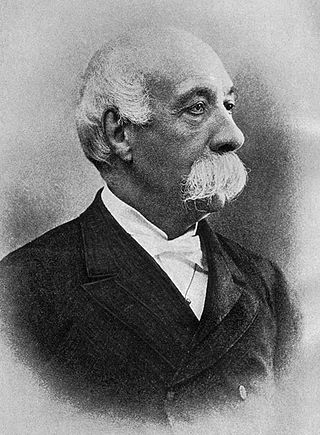
Francesco Crispi was an Italian patriot and statesman. He was among the main protagonists of the Risorgimento, a close friend and supporter of Giuseppe Mazzini and Giuseppe Garibaldi, and one of the architects of Italian unification in 1860. Crispi served as Prime Minister of Italy for six years, from 1887 to 1891, and again from 1893 to 1896, and was the first Prime Minister from Southern Italy. Crispi was internationally famous and often mentioned along with world statesmen such as Otto von Bismarck, William Ewart Gladstone, and Robert Gascoyne-Cecil, 3rd Marquess of Salisbury.

Yohannes IV was Emperor of Ethiopia from 1871 to his death in 1889 at the Battle of Gallabat, and king of Tigray from 1869 to 1871. During his reign he successfully defended Ethiopia against a large scale Egyptian invasion.
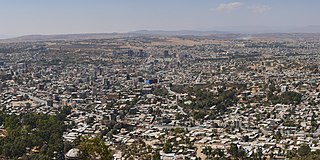
Mekelle, or Mekele, is a special zone and capital of the Tigray Region of Ethiopia. Mekelle was formerly the capital of Enderta awraja in Tigray. It is located around 780 kilometres (480 mi) north of the Ethiopian capital Addis Ababa, with an elevation of 2,254 metres (7,395 ft) above sea level. Administratively, Mekelle is considered a Special Zone, which is divided into seven sub-cities. It is the economic, cultural, and political hub of northern Ethiopia.

Oreste Baratieri was an Italian general and governor of Italian Eritrea.
The Treaty of Addis Ababa, signed 23 October 1896, formally ended the First Italo-Ethiopian War on terms mostly favorable to Ethiopia. This treaty superseded a secret agreement between Ethiopia and Italy negotiated days after the decisive Battle of Adwa in March of the same year, in which Ethiopian forces commanded by Menelik II defeated the Italians. The most important concession the Italians made was the abrogation of the Treaty of Wuchale and recognizing Ethiopia as an independent country.

RasMengesha Yohannes was governor of Tigray and a son of atse Yohannes IV. His mother was Welette Tekle Haymanot wife of dejazmach Gugsa Mercha. Ras Araya Selassie Yohannes was his older half brother. Prior to the Battle of Metemma, Mengesha Yohannes was considered to be a nephew of Emperor Yohannes IV. During the battle, the Emperor was mortally wounded and it was on his deathbed that Mengesha Yohannes was acknowledged as his "natural" son and designated as his heir. This created something of a succession problem.

The Battle of Gallabat was an armed conflict fought on 9–10 March 1889 between the Mahdist Sudanese and Ethiopian forces. It is a critical event in Ethiopian history because Nəgusä Nägäst Yohannes IV was killed in this battle, and because it was the last major battle on the Ethiopian front of the Mahdist War. The fighting occurred at the site of the twin settlements of Gallabat and Metemma, so both names are commonly used and either can be argued to be correct.

The Battle of Coatit was fought on 13 January 1895 between Italy and Ethiopian proxies led by Tigrayan warlord Ras Mengesha Yohannes in what is now Eritrea. It was the opening battle of the First Italo–Ethiopian War, and was a significant victory for the Italians, as they rebuffed an invasion force.

The Army of the Ethiopian Empire was the principal land warfare force of the Ethiopian Empire and had naval and air force branches in the 20th century. The organization existed in multiple forms throughout the history of the Ethiopian Empire from its foundation in 1270 by Emperor Yekuno Amlak, to the overthrow of the monarchy and Emperor Haile Selassie in 1974 by members of the Ethiopian army. Due to the country's position along multiple trade routes and its maintenance of independence against multiple Islamic and colonialist invasions lead to multiple conflicts against numerous major countries including the Ottomans, Egyptians, British, and Italians.

Giuseppe Galliano was an officer of the Royal Italian Army, mostly known for his role during the First Italo-Ethiopian War. He perished in the Battle of Adwa and was posthumously awarded the Gold Medal of Military Valour.
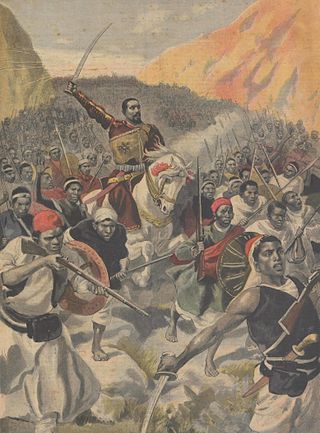
The Battle of Amba Alagi was the first in a series of battles between the Italian General Baratieri and Ethiopia's Emperor Menelik during the First Italo-Ethiopian War. Amba Alagi was one of Baratieri's forward positions; it was under the command of Major Toselli with 2,000 Eritrean Askari. On 7 December 1895, the Ras Makonnen, Fitawrari Gebeyehu and Ras Mengesha Yohannes commanded an assault of Menelik's vanguard that annihilated the Italians and killed Major Toselli.
Events from the year 1896 in Italy.
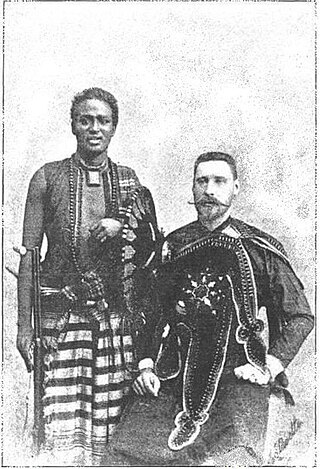
Nikolay Stepanovich Leontiev, 1st Count of Abai, was a Russian military officer, geographer and traveler, explorer of Africa, writer, and veteran of the Boxer Rebellion, and the Russo-Japanese War.
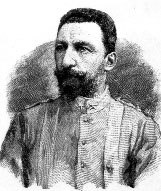
Giuseppe Edoardo Arimondi, OSML, OMS, OCI was an Italian general, mostly known for his role during the First Italo-Ethiopian War. He was one of the few European commanders who gained a victory over the Mahdists before Kitchener's Expedition, soundly defeating them at Agordat in 1893. After a long and successful colonial service, he died in combat at Adwa, and was posthumously awarded the Gold Medal of Military Valour.
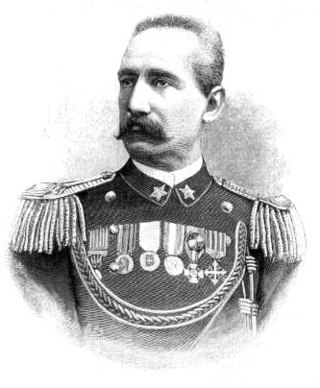
Matteo Francesco AlbertoneOCI was an Italian general, mostly known for his role during the First Italo-Ethiopian War. He led the Native Brigade during the battle of Adwa and was taken prisoner by the Ethiopians.

The Italo-Ethiopian War of 1887–1889 was an undeclared war between the Kingdom of Italy and the Ethiopian Empire occurring during the Italian colonization of Eritrea. The conflict ended with a treaty of friendship, which delimited the border between Ethiopia and Italian Eritrea but contained clauses whose different interpretations led to another Italo-Ethiopian war.





















